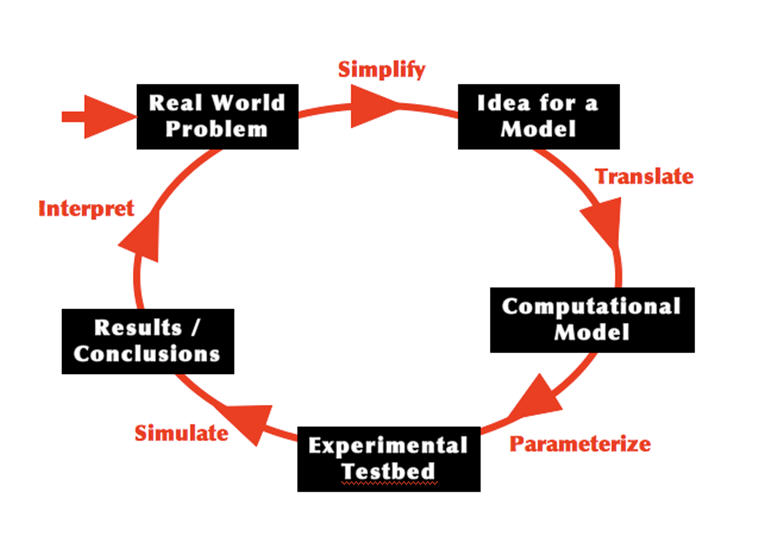
| About | Resources | Archive | Newsflash |
Class MaterialsClass material from the Kickoff Conference.
Introduction to Computational Science, Modeling and ImplementationData Analysis
Meet the Scientist/Proposal ReviewThe facilitators/instructors/scientists will meet the students in their teams. The students will have copies of their proposals with them and their Computational Science Process form. The Meet the Scientist Proposal Review form will be filled out. Volunteer scientists should look over the Meet the Scientist (MTS) Overview Document. The purpose of the session is to make sure teams have chosen a problem that is suitable for computational science, has measurable components so that a mathematical model can be developed, and from that a computing solution can be written. The session is secondarily about mentoring teams who have good proposals and are ready to get started on their projects. Meet the Scientist is a key session for helping students get off to a good start on their projects. For info about Proposals, see: http://www.supercomputingchallenge.org/proposals. This year in order to give the students more time to program, we are not including an introductory class which outlines computational science processes and modeling. Please lead students to consider the steps they should take to complete their projects. The graphic below shows that process. Irene Lee developed it and the commentary below.
We start with a real world problem, and a question. We make sure that our problem's solution will rely on data. We simplify the real world problem - and not the assumptions we have made. We do research to find out as much as we can about the idea. We come up with an idea model - (not an attempt at exact duplication of the real world) - assumptions are acknowledged. However, it is important to be able to describe the idea in English or pseudo code language before building the computational model. We use the computational model as an experimental test bed complete with variables and parameters. Goal is to understand primarily this model, and see how it can help us understand the real world.
We would like each session to start with one or a team of Scientists outlining for their group what a computational science process looks like. The diagram above can be printed and available for sharing with the students or it could be projected on a laptop. We anticipate that this overview will take place at the table with the students you are working with. Ways that the process relates to the work that you do will increase their understanding. Students will come to a table that they believe reflects the core science of their project. Topics in the past have included: Engineering, AI/Logistics, music, biology, physics, earth and space sciences, epidemiology, applied mathematics, computer science, behavioral science, chemistry, medicine and health, geology, entomology. David Janecky, an experienced mentor and judge who has participated in many Meet the Scientist sessions reminded us last year that: "..the list of topics you have is pretty good. In part, I don't think substantial granularity of topic areas is critical because the mentoring, mid-project evaluations, and then EXPO/Finalist judging will also be inherently multidisciplinary. And I am biased that broad communication is an essential skill that should be learned early and often. We should make sure that we define the high level topics in opening remarks as including aspects of the more generic disciplines (threads)." Students should have in hand a hard copy of the proposal they (should) have submitted before arriving at the Kickoff. Some students will come to this session and not have submitted a proposal and will need help from scratch. These students should be encouraged to write a proposal after they visit with the Scientist. If there is time, they can share it with the same or another Scientist. Some students may need to make modifications or even rewrite their proposals so that they meet the criteria for computational science. At one table Kathy Pallis and Susanne King from LANL will be available to guide students towards the completion of written reports. Students whose proposals have been reviewed or are waiting for a spot at one of the tables can sit down with Kathy and Susanne for mentoring about keeping track of their research and citing it. Students whose proposals are complete can move to computers to begin research or work at tables to plan their timeline, assign tasks to different members of the team, etc. If there are facilitators who are not working with teams to get their proposals completed it would be helpful if they could do some mentoring of teams who are ready. Computers are available in the Open Lab on the first floor of Fidel and students can go there to work on proposals or their projects. It may be helpful to look at the proposal guidelines and the proposals that are already up on the Challenge web page - http://www.supercomputingchallenge.org/proposals. There is also a link on the web page for questions to ask to direct the students: http://www.supercomputingchallenge.org/kickoff/classes/tpd.html. Additionally, http://www.supercomputingchallenge.org/about/areas.shtml links to areas of science and may be helpful for teams still looking for an idea. This guidelines link can be useful, too. http://www.supercomputingchallenge.org/about/guidelines.shtml. You can see which teams have submitted proposal on the proposals page of the Challenge web site, http://www.supercomputingchallenge.org/proposals. Back to the topReport Writing Workshop materials
StarLogoNetLogo 1
NetLogo 2
Teamwork ClassParallel Processing Class
Shallow Water ClassOptimization Class
Visualization ClassQuestions? Contact Consult |
|
For questions about the Supercomputing Challenge, a 501(c)3 organization, contact us at: consult @ challenge.nm.org |

|
